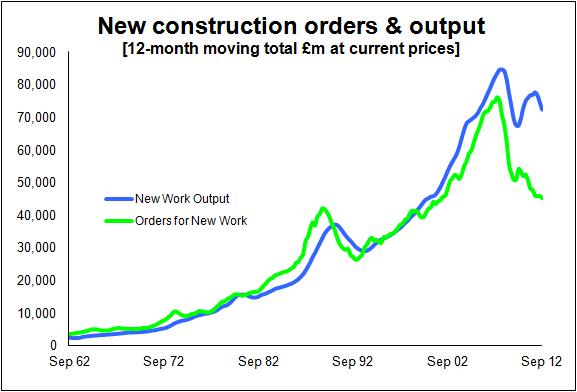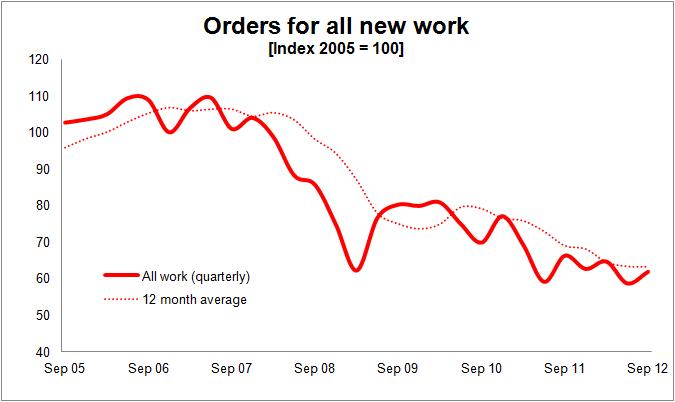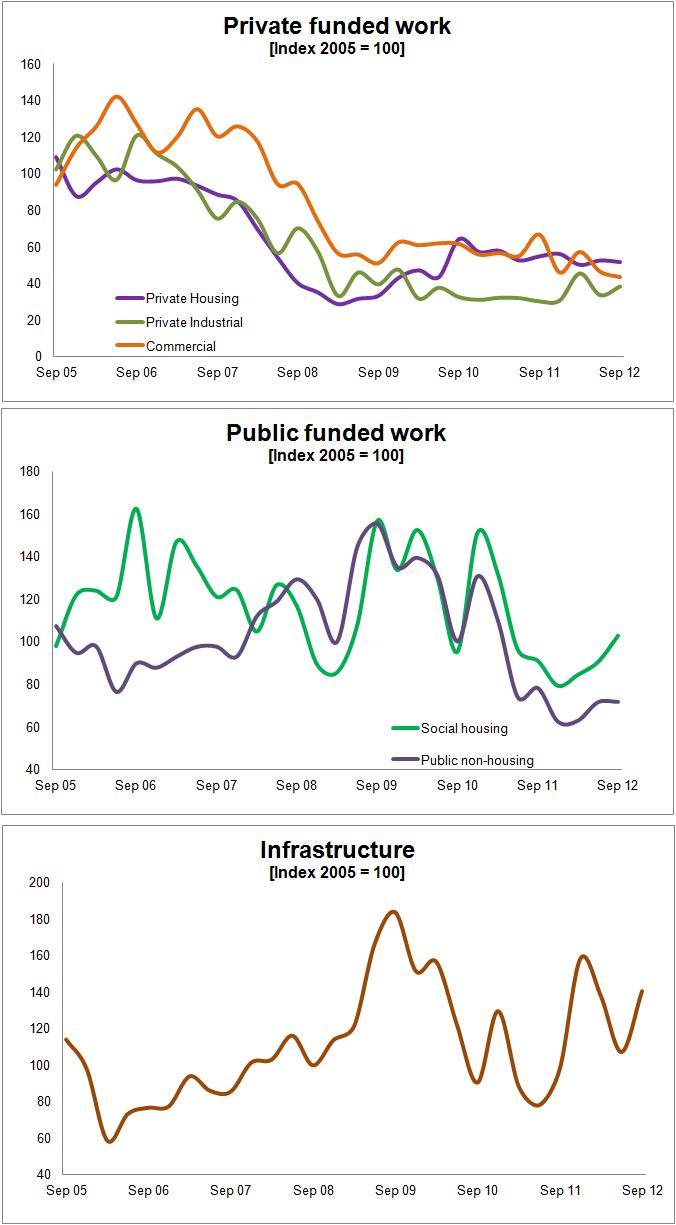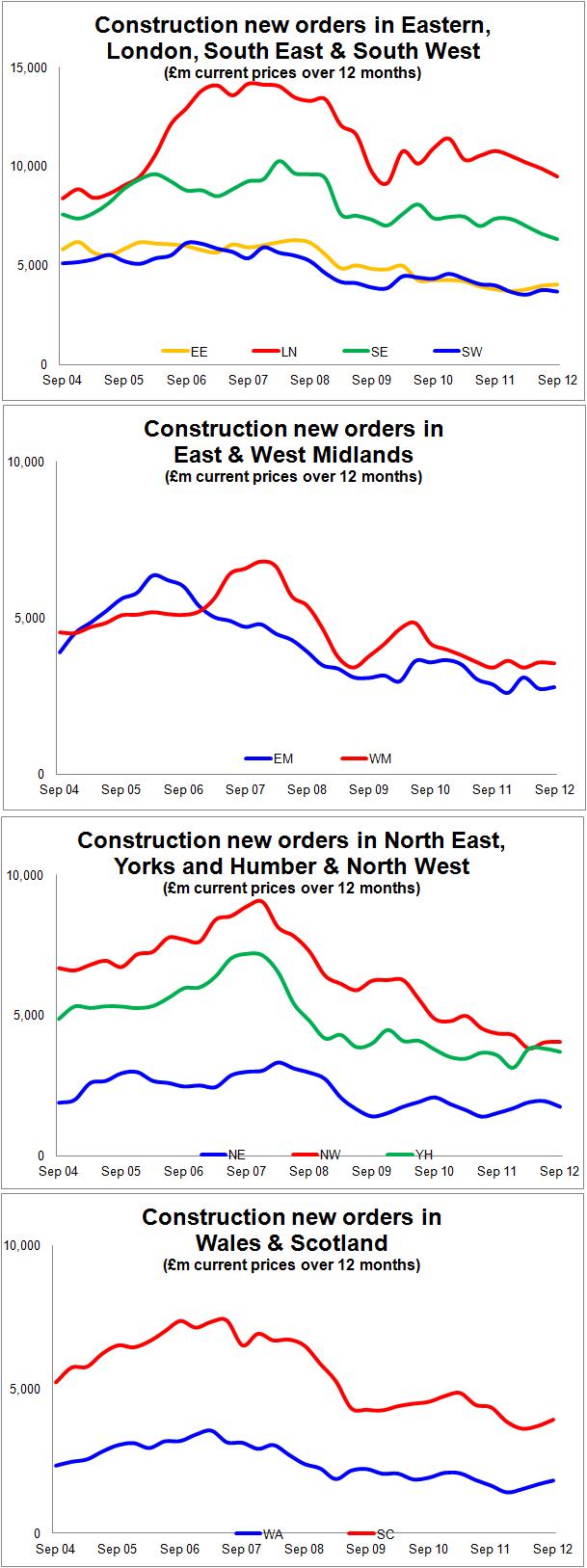Latest new orders figures cast a long dark shadow over construction
The construction new orders figures released by the Office for National Statistics on Friday suggest a truly scary year or more for the UK industry.
We can find some solace in the general rule that it is unwise to take as your guide just one measure of activity in construction, given the trickiness of measuring the industry’s activity. There are much less worrisome measures of construction activity to be found.
But let’s consider what conclusions we might draw if we did take the official new orders for construction data in isolation as our sole forward indicator of work on the ground.
 The most likely conclusion we’d draw is that even the very gloomy predictions made by the construction industry forecasters would start to look grossly optimistic.
The most likely conclusion we’d draw is that even the very gloomy predictions made by the construction industry forecasters would start to look grossly optimistic.
If you look at where new orders are now, where new work output stands and how the two have been linked in the past (graph right) you might conclude that the new work segment of construction could fall by almost a third.
Before we get too carried away with gloom, what do the latest new orders figures say and why should we be concerned?
Well in truth little has changed over the past quarter. Indeed the data show some growth in orders quarter on quarter. But there has been far too little.
Only a fool would look at the latest numbers and smile at the 5.4% rise in the volume of new orders in the third quarter compared with the previous quarter and surmise that the industry was receiving a boost. A lesser fool might look at the near 40% increase in infrastructure orders won over the past 12 months compared with the previous 12 months and think that infrastructure spending will spare construction from a nasty slump.
No. If we look at this data in the round and if we confine ourselves just to looking at the ONS data it would be reasonable to assume that we need sustained stellar growth in the new orders to reach a level that might support stability in construction output.
 The data show that for the past 18 months firms have been winning just 60% of the amount of new work they were in 2007 (graph right).
The data show that for the past 18 months firms have been winning just 60% of the amount of new work they were in 2007 (graph right).
With new orders at this level for this length of time it is hard to see how the industry can avoid a very sharp fall in output in the not too distant future. That’s unless something is awry with the data.
But before considering whether there are problems with the data or what these latest figures mean as they stand, it is worth recapping what the data represent. These data are for new work, so do not cover repair and maintenance construction work.
It’s worth noting also the relationship between the construction output (work on the ground) data and the new orders figures. The top graph shows that there had been until the recession a fairly close relationship between the two, albeit with a lag. This we might expect. That said the correlation has seemingly weakened in recent years.
But we wouldn’t have expected a totally straightforward and linear relationship. There are some variable lag effects and there is a great deal of heterogeneity in the size and type of the work being measured. So there will be issues of deflators and seasonal adjustments that will influence the volume data.
A reasonable way of thinking of new orders is the similarity with putting fuel in a petrol tank. You can put off filling up for a bit, but sooner rather than later the tank will empty. Or you can put a whole load in that will last for a long while. From this you can appreciate that any link between the level of new orders and the level of output of new work will decouple at points.
There were many very large contracts that were let before and just after the recession hit. These will have flattered the peak. Similarly they will have run for some time buoying industry output. This may well have changed the pattern of the relationship between orders and output.
Meanwhile, construction work ordered is not necessarily what is delivered. There can be, for instances, changes in the specification that increase or decrease the amount of work actually done (the output) relative to the order. And in a recession we would expect contractors to price keenly (suppressing the new orders figures) in the hope of making better money on the job itself.
Speculating heavily, the changing methods of procurement adopted in recent years may have disrupted the relationship still further and may be one reason for the weaker correlation in recent years. It may be that significant elements of work allocated to contractors are no longer picked up in the new orders survey.
There will also be slight differences in how the gathered data are treated statistically. And there a plenty of factors that would cause the two sets of data to diverge, especially during a recession.
So there are reasons not to panic over a moderate divergence between the two lines. The optimist may seek comfort in the belief that a relationship that has been pretty close for many years has suddenly fallen apart for quirky statistical reasons. That I suggest would be optimism in the extreme.
The ONS continues to investigate why the connection between new orders and output of new work has changed so markedly. But until it finds and answer I would view the new orders data as extremely worrying.
Perhaps more disturbing, leaving aside the level, is that the sectors upon which we rely for eventual growth, private housing and private commercial, appear to be offering very little.
On a cash basis, new orders for private housing work over the past 12 months is running at about 60% of peak level. The cash value of new orders for retail work is below 40% of peak level and for offices the level if below a quarter.
Okay, infrastructure spending is up. But even at its supercharged current level the value of new orders for infrastructure is still far below the peak level reached by the offices sector alone.
Regionally the picture varies, with London having been sheltered from some of the worst. But even here we are seeing a falling away of new orders of late. This, in theory, will see even this bastion of hope drop into a nasty recession.
Yes, there are less pessimistic indicators of the state of construction. And there is always good reason to query the accuracy of any data, but it would be a brave business that chose to totally ignore the official statistics when planning its future.
See below graphs illustrating regional and sector new orders:

